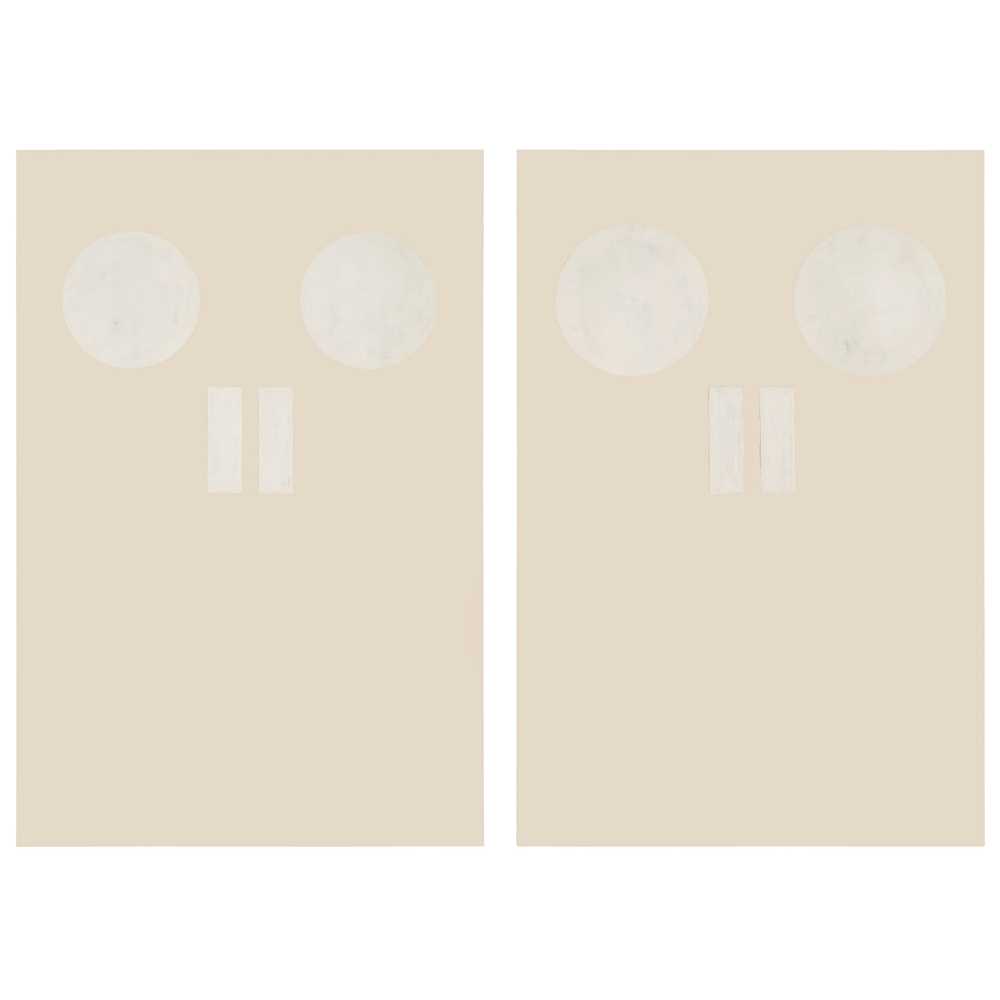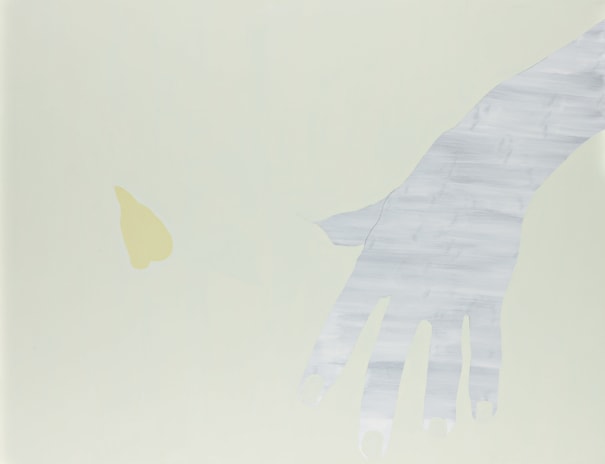PROPERTY FROM THE ESTATE OF PENTTI KOURI Gary Hume Rose enamel paint on aluminum 304.8 x 243.8 cm. (120 x 96 in.) Painted in 1999.
Provenance White Cube, London Phillips de Pury & Company, New York, 10 November 2005, lot 17 Private Collection Acquired from the above by the present owner Catalogue Essay With its blush-pink hue and weaving white forms, Gary Hume’s monumental painting Rose perfectly and playfully probes the limits of the figurative and the formal in art. Painted in 1999, the magnificent scale and industrial, high-gloss finish of Rose are at deliberate odds with the subject matter suggested by the title, which hints at some intimate floral image. Instead, we are presented with a vast surface that hovers ambiguously between the realms of the abstract and the representative. Combining this with his techniques, which involve projection, metal supports and household paints, Hume throws into question the entire nature of painting. The work’s title, Rose, is a homonym which could refer to either the delicate tone of pink or the thorny, flowering garden plant from which the colour gets its name. By hinting at a subject matter that defies immediate visual recognition in the criss-crossing white streaks, Hume endows Rose with a reticence, an inscrutability. At the time that he painted Rose, Hume typically traced source images onto sheets of acetate, using them to project his subject onto the aluminium supports he favoured since the mid-1990s. Where many of these subjects were from commercial images in magazines, the convoluted forms in Rose are more self-reflexive: they derive from a closely cropped section of one of Hume’s own drawings. This was made for Yellow Angels, another painting from 1999, which was exhibited in the British Pavilion at the Venice Biennale the same year and is now in the Art Institute of Chicago. The source image depicts dozens of angels that are overlaid such that the forms interlace and they lose figurative definition. In the present work Hume abstracts this image further, focusing more readily on the formal properties of minutiae that would otherwise be overlooked. Hume’s focus deliberately decontextualises his own source material, pushing it further towards the brink of abstraction. By magnifying and paring back his imagery in this way, and presenting it on a vast, sheer support, Hume strips away its original purpose or content, yet creates a composition that nonetheless draws in the viewer. Through these means—reinforced by the lack of specificity and misleading nature of the title—the viewer can only attempt to rationalise the dancing lines of sheer white paint that carve their elusive patterns in the unremitting sea of pink, opening Rose up to subjective interpretation. As Adrian Searle wrote in 1999, the year that Rose was painted, ‘what remains is a strangeness, a sense of things frozen and suspended in the painting’s silence’ (Adrian Searle Behind the Face of the Door, Gary Hume XLVII Venice Biennale, exh. cat. British Pavillion, Venice, 1999, p. 10). Hume’s use of household paints to depict familiar subjects emphasises this strangeness, this surreal quality. In using a domestic material, he is both cocking a snook at the art establishment, and indeed the entire notion of fine arts, and also appears to invoke Sigmund Freud’s concept of the ‘Uncanny’, or Unheimlich. For Freud, there was a grey area between the ‘Heimlich’ and the ‘Unheimlich’, and this is encapsulated in Hume’s ability to present familiar subjects using familiar materials in a manner that is transformative and indeed provocative. He uses the ordinary to invoke the extraordinary. Rose was painted at a crucial time in the artist’s career. In 1999, just three years after being nominated for the Turner Prize, Hume was asked to represent Britain at the Venice Biennale. This garnered him critical acclaim and consequently became the springboard for his inclusion in a series of important exhibitions at Whitechapel Gallery, London, the Hammer Museum, Los Angeles, and the Museum of Contemporary Art, Chicago the same year. Read More
PROPERTY FROM THE ESTATE OF PENTTI KOURI Gary Hume Rose enamel paint on aluminum 304.8 x 243.8 cm. (120 x 96 in.) Painted in 1999.
Provenance White Cube, London Phillips de Pury & Company, New York, 10 November 2005, lot 17 Private Collection Acquired from the above by the present owner Catalogue Essay With its blush-pink hue and weaving white forms, Gary Hume’s monumental painting Rose perfectly and playfully probes the limits of the figurative and the formal in art. Painted in 1999, the magnificent scale and industrial, high-gloss finish of Rose are at deliberate odds with the subject matter suggested by the title, which hints at some intimate floral image. Instead, we are presented with a vast surface that hovers ambiguously between the realms of the abstract and the representative. Combining this with his techniques, which involve projection, metal supports and household paints, Hume throws into question the entire nature of painting. The work’s title, Rose, is a homonym which could refer to either the delicate tone of pink or the thorny, flowering garden plant from which the colour gets its name. By hinting at a subject matter that defies immediate visual recognition in the criss-crossing white streaks, Hume endows Rose with a reticence, an inscrutability. At the time that he painted Rose, Hume typically traced source images onto sheets of acetate, using them to project his subject onto the aluminium supports he favoured since the mid-1990s. Where many of these subjects were from commercial images in magazines, the convoluted forms in Rose are more self-reflexive: they derive from a closely cropped section of one of Hume’s own drawings. This was made for Yellow Angels, another painting from 1999, which was exhibited in the British Pavilion at the Venice Biennale the same year and is now in the Art Institute of Chicago. The source image depicts dozens of angels that are overlaid such that the forms interlace and they lose figurative definition. In the present work Hume abstracts this image further, focusing more readily on the formal properties of minutiae that would otherwise be overlooked. Hume’s focus deliberately decontextualises his own source material, pushing it further towards the brink of abstraction. By magnifying and paring back his imagery in this way, and presenting it on a vast, sheer support, Hume strips away its original purpose or content, yet creates a composition that nonetheless draws in the viewer. Through these means—reinforced by the lack of specificity and misleading nature of the title—the viewer can only attempt to rationalise the dancing lines of sheer white paint that carve their elusive patterns in the unremitting sea of pink, opening Rose up to subjective interpretation. As Adrian Searle wrote in 1999, the year that Rose was painted, ‘what remains is a strangeness, a sense of things frozen and suspended in the painting’s silence’ (Adrian Searle Behind the Face of the Door, Gary Hume XLVII Venice Biennale, exh. cat. British Pavillion, Venice, 1999, p. 10). Hume’s use of household paints to depict familiar subjects emphasises this strangeness, this surreal quality. In using a domestic material, he is both cocking a snook at the art establishment, and indeed the entire notion of fine arts, and also appears to invoke Sigmund Freud’s concept of the ‘Uncanny’, or Unheimlich. For Freud, there was a grey area between the ‘Heimlich’ and the ‘Unheimlich’, and this is encapsulated in Hume’s ability to present familiar subjects using familiar materials in a manner that is transformative and indeed provocative. He uses the ordinary to invoke the extraordinary. Rose was painted at a crucial time in the artist’s career. In 1999, just three years after being nominated for the Turner Prize, Hume was asked to represent Britain at the Venice Biennale. This garnered him critical acclaim and consequently became the springboard for his inclusion in a series of important exhibitions at Whitechapel Gallery, London, the Hammer Museum, Los Angeles, and the Museum of Contemporary Art, Chicago the same year. Read More




.jpg)
.jpg)
.jpg)
.jpg)






Testen Sie LotSearch und seine Premium-Features 7 Tage - ohne Kosten!
Lassen Sie sich automatisch über neue Objekte in kommenden Auktionen benachrichtigen.
Suchauftrag anlegen